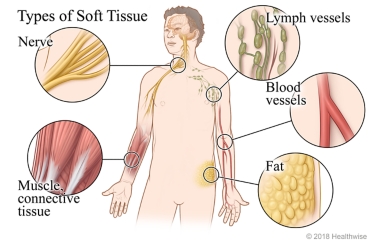What is a soft tissue sarcoma?

A soft tissue sarcoma is a growth of abnormal cells in the body's soft tissues. These tissues include the muscles, lymph and blood vessels, nerves, and fat. It can also include cartilage and other connective tissue. When cancer cells are found in the tissue, the tumor is called malignant.
Sarcoma is another name for a malignant soft tissue tumor. Sarcomas can spread to other parts of the body, like the lungs.
What are some common types?
Some common types of soft tissue sarcomas include:
- Undifferentiated and unclassified sarcomas. These tumors are more common in older adults. They often appear in the arms or legs but can be found anywhere in the body.
- Gastrointestinal stromal tumors (GIST). This cancer forms in the gastrointestinal (GI) tract. It's usually in the stomach or small intestine.
- Liposarcomas. This type of soft tissue tumor is made up of fat cells. It can be found anywhere in the body.
- Leiomyosarcoma. These tumors are often found in the muscles in the belly and in the uterus, the stomach, and the small intestine.
Other types of soft tissue tumors may appear on the skin, nerves, belly, and limbs. Examples include Ewing, Kaposi, and epithelioid sarcomas.
What are the symptoms?
You may feel a swelling or lump near the tumor. Or you may feel pain or have trouble breathing if the tumor grows large enough to press against nerves or organs inside your body.
How are they diagnosed?
Your doctor will ask you about your symptoms and past health and will examine you. If your doctor can feel a lump or mass in the soft tissue, or if you have other symptoms, you will get some tests. The tests can find out if it's cancer. They can also help your doctor figure out the best treatment for the tumor.
Your doctor may also find a tumor when taking X-rays or other images for another problem.
- You may have one or more imaging tests to get a better look at the tumor. These may include:
- X-rays.
- Ultrasound.
- CT scan.
- MRI scan.
- PET or other nuclear scan.
- You may need blood tests and other lab work.
- You may need a biopsy so that a sample of the tumor can be looked at under a microscope. This sample may also be used to test for biomarkers, which will help with planning treatment.
- Doctors may also examine other parts of your body to make sure that the tumor hasn't spread.
The doctor may talk to you about what "stage" your cancer is. The stage refers to how large the tumor is and how far it has spread. It also includes the tumor grade, which describes what the cancer cells look like and how likely they are to grow and spread.
These can help the doctor find out what type of treatment you may need. And they may help to find a clinical trial that has treatments for your type of cancer.
How are they treated?
Treatment for a soft tissue sarcoma is based on the stage, type, and location of the cancer and other things, such as your overall health. The main treatments include:
- Surgery.You'll probably have surgery to remove the cancer.
- Radiation therapy. This uses high-dose X-rays to destroy cancer cells and shrink tumors. It may be used before, during, or after surgery.
- Chemotherapy. These medicines kill fast-growing cells, including cancer cells and some normal cells.
In some cases, other treatments may be used, such as:
- Targeted therapy. These medicines target cancer cells and may cause less harm to normal cells. They help keep cancer from growing or spreading.
- Immunotherapy. This treatment helps your immune system fight cancer. It may be given in several ways.
Sometimes a clinical trial may be a good choice.
Your doctor will talk with you about your options and then make a treatment plan.
What are some other things to think about?
- Some tumors are aggressive and need treatment right away. But most cancer grows slowly enough that you can take a little time to find out more about your cancer as you decide about treatment.
- Think about getting a second opinion from another doctor. Before you start major treatment, it's a good idea to check with another doctor about the type of cancer you have and the stage of your cancer. Your doctor or insurance company can recommend someone for a second opinion.
- Ask any questions you might have. You can talk to your doctor, nurses, counselors, and other advisors.
- Talk to family, friends, and supporters. Get the kinds of help you need.
Follow-up care is a key part of your treatment and safety. Be sure to make and go to all appointments, and contact your doctor if you are having problems. It's also a good idea to know your test results and keep a list of the medicines you take.
Current as of: October 25, 2024
Author: Ignite Healthwise, LLC Staff
Clinical Review Board
All Ignite Healthwise, LLC education is reviewed by a team that includes physicians, nurses, advanced practitioners, registered dieticians, and other healthcare professionals.

